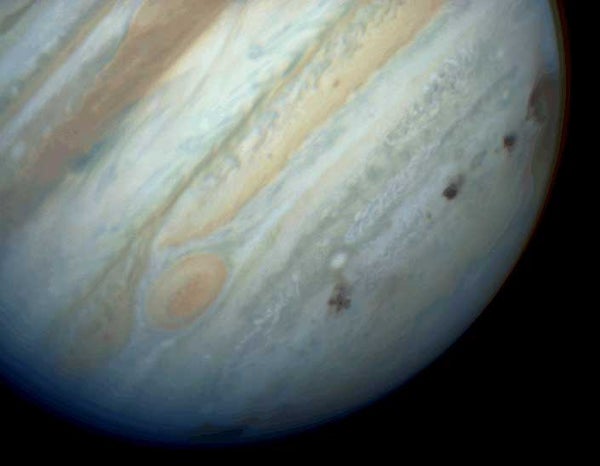Slightly more than 21 years have passed since Comet Shoemaker–Levy 9 broke apart and slammed into Jupiter. Although the physical scars of those cataclysmic collisions have long since vanished, researchers are still gaining new insights into the solar system based on that decades-old catastrophe. David Levy, who co-discovered the comet with Eugene and Carolyn Shoemaker, reflects on his 50 years as a comet hunter in the February issue of Scientific American.
In 2011 researchers at the SETI (Search for Extraterrestrial Intelligence) Institute and Cornell University determined that the force of the Shoemaker–Levy collisions was powerful enough to tilt the thin planetary ring that surrounds Jupiter by two kilometers. Although the fragmented comet never crossed the ring's plane, its impacts spewed a stream of cometary dust back into space and into the ring, which resulted in a peculiar pattern of ripples that were first observed by the Galileo orbiter in 1996.
In 2013 European and U.S. scientists reported that more than 95 percent of the water found in the upper reaches of the Jovian atmosphere probably comes from the comet. Water vapor had been detected during the initial explosions back in 1994 but figuring out exactly what happened to it was not possible at the time. Using infrared and spectroscopy instruments on the Herschel Space Observatory, which was launched in 2009, the researchers mapped the location and concentration of water in Jupiter's stratosphere and determined that most of it could be found in the planet’s southern hemisphere within a band consistent with the comet's final trajectory.
On supporting science journalism
If you're enjoying this article, consider supporting our award-winning journalism by subscribing. By purchasing a subscription you are helping to ensure the future of impactful stories about the discoveries and ideas shaping our world today.
Shoemaker–Levy 9 also had an indirect effect on U.S. space policy. Previously, the idea of a giant space rock (whether comet or asteroid) slamming into Earth seemed much too remote a possibility to worry about—even if such a collision most likely helped end the age of the dinosaurs. But in 1994 the largest of the more than 20 cometary fragments hit Jupiter with a force equivalent to six million megatons of TNT, as calculated by Eugene Shoemaker at the time. By contrast, the world's nuclear arsenal reached a potential yield of around 25,000 megatons at its peak in 1974. Hans Kristensen, director of the Nuclear Information Project at the Federation of American Scientists, estimates the current global stockpile is around 2,520 megatons (although only a portion of this megatonnage is fully deployed). That's the equivlanet of about 210,000 Hiroshima bombs.
Any way you figure it, a Shoemaker-Levy type collision with Earth would mean the end of civilization as we know it. Hollywood responded with the movies Armageddon and Deep Impact, which vividly, if often inaccurately, depicted the resulting devastation. A Congressional House committee asked NASA to find and keep track of the number of objects in space that might cross Earth's orbit and could trigger extinction-level events if they slammed into the planet.
To date, NASA believes there are more than 878 near-Earth asteroids one kilometer or more in diameter, of which they calculate 90 percent now have been discovered. None of them are thought to threaten Earth for centuries to come. But as the dinosaurs who once ruled the planet might have observed, it only takes one to shoot down world domination.
